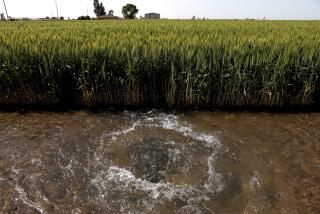Senate Bill Would Require Drain Covers on Swimming Pools
- Share via
WASHINGTON — Each year, about 225 children under 5 drown in swimming pools, a leading cause of accidental death for that age group.
To help prevent such accidents, legislation introduced Monday in the Senate would require owners of swimming pools, hot tubs and spas to install suction-reducing drain covers to prevent children’s hair and bodies from getting caught in high-powered suction devices, trapping them at the bottom of the pool. The plastic covers cost about $30.
“I think our children will be cheering,” said Nancy Baker, daughter-in-law of former Secretary of State James A. Baker III. Her 7-year-old daughter died in 2002 after a spa drain trapped her underwater. If the legislation saves someone “the days and nights and months of pain and grief and tears, then it’s not all for naught,” she said.
The bill’s author, Sen. George Allen (R-Va.), said drains could exert 400 pounds of suction pressure. Using the covers, he said, is a common-sense approach: “It’s simple, effective, inexpensive and it saves children’s lives.”
These accidents are a national problem, said Nadina Riggsbee, founder of the Drowning Prevention Foundation in Alamo, Calif.
“The pool is a fun, wonderful place, but it’s also a death trap when it comes to small children,” said Riggsbee, whose two toddlers were found face-down in the family pool in 1978; one died, and the other was irreversibly brain-damaged.
According to the Centers for Disease Control and Prevention, most child drownings happen at home. And as backyard pools become more affordable and common, drain entrapment is an increasing concern for state and federal legislators.
The Assn. of Pool and Spa Professionals estimates that the number of residential pool owners increased by 600,000, to more than 8 million, from 2001 to 2004, and hot tub owners increased by about 800,000, to more than 5 million.
California leads the nation in both categories, according to the association, with about 1.4 million pools and 1.5 million hot tubs. Los Angeles County has the largest number of pools, 183,000, followed by Orange County with 114,500 pools, Ventura County with 83,900, and San Bernardino County with 77,000. Riverside County ranks sixth, behind San Diego.
The legislation would give pool owners a year to install protective drain covers. New pool owners could either use the protective cover or install more than one drain. (Increasing the number of drains decreases the suction.)
Allen said the bill would include a $5-million incentive for education programs to raise public awareness. Enforcement would cost about $10 million, he predicted.
Rep. Debbie Wasserman Schultz (D-Fla.) introduced a similar bill this year. That House proposal addresses pool enclosures as well as drains.
Such measures, Wasserman Schultz warned, are not a substitute for parental supervision.
But, she added, “as a busy mother, I know that supervision does lapse, and when supervision does lapse, we must have an obstacle in the path of a child to prevent them from drowning.”
A handful of states, including California, have some form of “entrapment” law. In 1998, the California legislature passed a bill requiring barriers for new swimming pools. The mandate did not apply to older pools.
California has since introduced another pool safety bill, which has passed through the Assembly and one Senate committee. The legislation, introduced by Assemblyman Gene Mullin (D-San Mateo), would require at least two protective barriers, such as mesh fencing or an alarm on doors with pool access, for new pools and pools under renovation.
More to Read
Get the L.A. Times Politics newsletter
Deeply reported insights into legislation, politics and policy from Sacramento, Washington and beyond. In your inbox twice per week.
You may occasionally receive promotional content from the Los Angeles Times.










